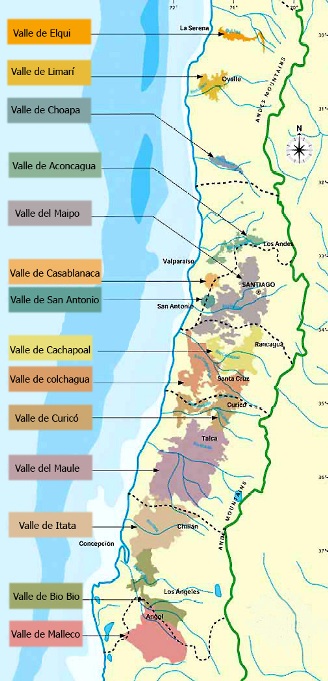Sommelier School
Lesson 28 – South America
South America. Another place that started making wine thanks to the Spanish missionaries. Since 1531 wine grapes have been grown here. It is also considered the second most important wine producing continent. Even so, South American wine hasn’t been a major player in wine until the latter part of the 20th century.
Besides the two countries that everyone knows produces wine (Argentina and Chile), Brazil, Uruguay, Bolivia, Venezuela, and Peru also make wine. For our purposes we will only concentrate on Argentina and Chile. Brazil, however, is one place to make note of for the future.
Chile
Chile is a very isolated country. The Andes mountains separate it from it’s neighbors Argentina to the east, Bolivia to the north and east, and Peru to the northwest. Then you have the Pacific Ocean to the west. It’s also the thinnest country in the world.
Of the two countries, Chile has the better quality overall. According to Tom Stevenson, Chilean wine, despite it’s quality, is grown in the wrong places. Since much of the population lives near Santiago, the capital, much of the wine grapes is grown nearby. Slowly other areas that can be considered more conducive to growing wine grapes have been getting more attention.
The climate of Chile is considered to be Mediterranean, with lots of sun. However depending on where you are at it can be very hot and dry in the north or cool and wet in the south. The Humboldt Current is also an influence but how much is dependent on the Coastal Range (similar to California). Around the capital of Santiago, it’s fairly dry with the Andes causing large temperature swings at night that helps to keep acid levels high.
The varietals that are grown here are the usual suspects. First there was Cabernet Sauvignon, Merlot, and Carmenère from the late 20th century. Later, the likes of Syrah, Pinot Noir, Malbec, Sauvignon Blanc, Chardonnay joined the ranks. In addition you’ll find Gewurztraminer, Viognier, and Riesling.
What has also helped Chilean wine is the influx of “flying winemakers” and foreign wine companies (mostly French, but some America and Spanish) coming in since the 1970s. They’re investments have helped to improve the quality of the wines coming out of Chile. Another improvement is switching from native beech (raule) to make barrels to mostly French barriques.
There are 5 main wine-growing regions in Chile with 18 sub-regions. They are listed below:
- Atacama
- Copiapó Valley
- Huasco Valley
- Central Valley (Valle Central)
- Curicó Valley
- Maipo Valley
- Maule Valley
- Claro Valley
- Lontue Valley
- Rapel Valley
- Colchagua Valley
- Cachapoal Valley
- Curicó Valley
- Tunue Valley
- Southern Chile
- Itata Valley
- Bio-Bio Valley
- Aconcagua
- Valley of Aconcagua
- Valley of Casablanca
- Coquimbo
- Elqui Valley
- Limarí Valley
- Choapa Valley

Source: http://www.chilean-wine.com/
Regions to pay attention to are the Central Valley and Aconcagua. The other three regions mainly produce table grapes, Pisco and Pais. Pisco is a distilled grape spirit. Pais is a red table wine made from the Pais grape. It’s the same as the Mission grape brought over by the missionaries from Spain. From the 16th Century up until the late 20th, Pais was the main wine in Chile.
Over the years there has been some debate about Sauvignon Blanc from Chile. The Chileans would lump a variety of grapes into a group called Sauvignonasse which means “Sauvignon-like.” After much research during the 1990s, much of the faux Sauvignon Blanc was replaced with actual Sauvignon Blanc.
Another varietal that has gotten some attention over the years is Carmenère. It was passed off as Merlot for a long time until it was discovered to be a different varietal.
Argentina
Across the Andes you’ll find the 5th largest producer of wine in the world, Argentina. For a long time the Argentine wine industry was more concerned about quantity rather than quality. And with that, it also consumed 90% of what was produced. It has only been recently that the quality has really started to improve and imports have risen since the 1990s. This is shown by the recent surge in popularity of Argentine Malbecs.
Wine making was brought here by the Spaniards in the 16th century. At first the vines didn’t do well along the Atlantic coast. Later vines were planted inland and did better. The Mission varietal was used. It’s known as the Criola Chica. The Criola Grande, which is a relative of the Criola Chica, became the main grape of Argentina. Currently the three most planted varietals for Argentina are Cereza, Malbec, and Criola Grande. Other popular varietals are Bonarda (not the same Bonarda from Piedmont, but most likely Savoie), Torrentés, Cabernet Sauvignon, Syrah, Chardonnay, Pedro Giménez (different but probably related to Pedro Ximénez), Termpranillo, and other international varietals.
The climate for the wine-growing regions is normally hot and dry. Typically more regions get no more than 10 inches of rain per year. As a result, irrigation is necessary. There’s plenty of water from the snow melt from the Andes to help. Sunshine is plentiful here too.
A large concern is what is known as the Zonda. A strong wind in the northwestern area that can literally deflower the vines. In addition to this, the area is typically dry during the growing season as mentioned above. This is helps prevent various diseases and rot from forming. This lack of humidity also allows many of the growers to not use chemicals to combat disease.
One other piece of knowledge to take from this is that both Chile and Argentina have been relatively phylloxera-free. This means that both countries have many varietals on original rootstock.
The main wine regions in Argentina are:
-
- Catamarca
- La Rioja
- Mendoza
- Rio Negro
- Salta
- San Juan
- Jujuy
- La Pampa
For the most part, Mendoza will be the one most people are familiar with. It is the leading producer of wine in the country. One of the areas within Mendoza that has seen considerable attention are the Uco Valley. After Mendoza San Juan and La Rioja are second in production. The next regions to look out for are those in the Northwest (Catamarca, Jujuy, and Salta).
Whether it’s Chile or Argentina, wines from here are of excellent value for the money. It’s not unusual to find wines under $20 or even under $10 that are outstanding.
Other areas on the horizon for South America are Brazil and Uruguay. The border between these two countries is an up-and-coming area for wine.
I’d like to welcome back everyone from a fairly long summer vacation. I plan on resuming a regular schedule again. The plan is to be back to weekly lessons. The next lesson will be Australia and New Zealand. That will probably take a couple lessons to complete.
To recap my summer, I successfully passed both the Certified Specialist of Wine and Introductory Sommelier exams. I can say that the two-day seminar for the Introductory Sommelier exam was a great review. The Master Sommeliers who conducted the sessions were great. It was a whirlwind pace, and they covered a lot of information that wasn’t necessarily for the first level exam, but it gave everyone a good idea what they needed to know for the next level or two.
I met some really cool people for the exam, and also the TexSom (Texas Sommelier) conference that followed the exam. I can’t wait to go back to the conference next year. I also plan on taking the Certified Exam at that time if it’s being offered the same weekend. I also hope to be prepared to pass Certified Wine Educator exam. Part of that is giving a presentation. Because the process is a bit drawn out, that might take me until 2012 to complete.
Thanks for watching/reading this lesson! I will see all of you next time!
Mark V. Fusco
CSW and Sommelier 🙂


